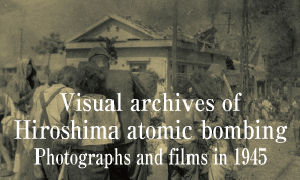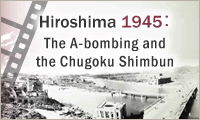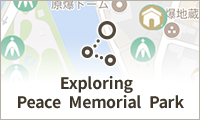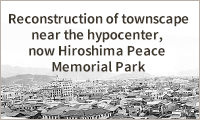Documenting Hiroshima of 1945: Around September 11, lines form in front of stand-up bars
Sep. 11, 2024
by Kyosuke Mizukawa, Senior Staff Writer
Around September 11, 1945, as people lined up to drink beer at a newly opened stand-up bar in front of Hiroshima Station (in the city’s present-day Minami Ward), Entaro Yamagami, a staff photographer for the Mainichi Newspapers Osaka head office, captured a photograph of the bar’s simple shack, which stood adjacent to the scorched ruins.
Previously, on September 6, the Chugoku Shimbun had reported the stand-up bar’s expected open in front of Hiroshima Station under the headline “Stand-up bar to freely sell beer in war-devastated Hiroshima.” According to the body of the article, “The Hiroshima branch of a government-controlled beer company made the decision to reward the efforts of people working to help in the recovery of Hiroshima City…”
Ichiro Osako, a former staff writer for Chugoku Shimbun, published Hiroshima Showa 20-nen (in English, ‘Hiroshima 1945’) in 1975, based on his journal. In the publication, he reported that the KIRIN Beer Hall (on site of present-day Hiroshima PARCO Main Wing), in the area of Horikawa-cho (in the city’s Naka Ward), had handled around 70 percent of the draft beer supplied to Hiroshima before the atomic bombing. Due to the controls placed on distribution, “beer vouchers” were necessary to receive beer.
Mr. Osako himself would visit the beer hall with beer vouchers in hand. In a journal entry dated May 4, 1945, he wrote, “Before 5 in the evening, more than 100 people had lined up.” Beer was poured into bamboo cylinders to create a foamy head and served with dried cod as a snack.
Except for the basement, the interior of the beer hall had been completely burned out by the atomic bombing. In September, like the one in front of the train station, a stand-up bar was established at the hall. In the publication 50-nen-shi (’50-year history’) of KIRIN Beer’s Hiroshima factory (established in Fuchu-cho in 1938), which was a beer supplier in Hiroshima from before the war, wrote that refreshment was not the only reason people in Hiroshima sought out beer after the atomic bombing. The book explained, “There were rumors that those who drank a large amount of beer would not develop A-bomb disease. They said beer could cleanse radiation from inside the body.”
Survivors’ immune systems had been left compromised, however, by reduced numbers of white blood cells. Masao Tsuzuki, professor at Tokyo Imperial University (present-day University of Tokyo), a specialist in radiation medicine, cautioned the public. “Drinking too much alcohol could cause disease,” he was reported as saying in a Chugoku Shimbun article published on September 12. Mr. Tsuzuki recommended instead that survivors consume vegetables rich in vitamins, such as tomatoes and pumpkins.
(Originally published on September 11, 2024)
Around September 11, 1945, as people lined up to drink beer at a newly opened stand-up bar in front of Hiroshima Station (in the city’s present-day Minami Ward), Entaro Yamagami, a staff photographer for the Mainichi Newspapers Osaka head office, captured a photograph of the bar’s simple shack, which stood adjacent to the scorched ruins.
Previously, on September 6, the Chugoku Shimbun had reported the stand-up bar’s expected open in front of Hiroshima Station under the headline “Stand-up bar to freely sell beer in war-devastated Hiroshima.” According to the body of the article, “The Hiroshima branch of a government-controlled beer company made the decision to reward the efforts of people working to help in the recovery of Hiroshima City…”
Ichiro Osako, a former staff writer for Chugoku Shimbun, published Hiroshima Showa 20-nen (in English, ‘Hiroshima 1945’) in 1975, based on his journal. In the publication, he reported that the KIRIN Beer Hall (on site of present-day Hiroshima PARCO Main Wing), in the area of Horikawa-cho (in the city’s Naka Ward), had handled around 70 percent of the draft beer supplied to Hiroshima before the atomic bombing. Due to the controls placed on distribution, “beer vouchers” were necessary to receive beer.
Mr. Osako himself would visit the beer hall with beer vouchers in hand. In a journal entry dated May 4, 1945, he wrote, “Before 5 in the evening, more than 100 people had lined up.” Beer was poured into bamboo cylinders to create a foamy head and served with dried cod as a snack.
Except for the basement, the interior of the beer hall had been completely burned out by the atomic bombing. In September, like the one in front of the train station, a stand-up bar was established at the hall. In the publication 50-nen-shi (’50-year history’) of KIRIN Beer’s Hiroshima factory (established in Fuchu-cho in 1938), which was a beer supplier in Hiroshima from before the war, wrote that refreshment was not the only reason people in Hiroshima sought out beer after the atomic bombing. The book explained, “There were rumors that those who drank a large amount of beer would not develop A-bomb disease. They said beer could cleanse radiation from inside the body.”
Survivors’ immune systems had been left compromised, however, by reduced numbers of white blood cells. Masao Tsuzuki, professor at Tokyo Imperial University (present-day University of Tokyo), a specialist in radiation medicine, cautioned the public. “Drinking too much alcohol could cause disease,” he was reported as saying in a Chugoku Shimbun article published on September 12. Mr. Tsuzuki recommended instead that survivors consume vegetables rich in vitamins, such as tomatoes and pumpkins.
(Originally published on September 11, 2024)






